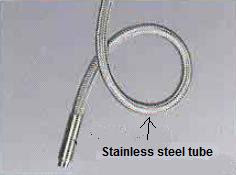Let me list down a few types and when to actually use each of them.
- Single core fiber optic sensor head. This is actually a conventional fiber optic sensor head. It is normally used for a direct sensing where there is no mounting complication and minimal bending of the fiber head. Using this sensor head in harsh environment is not recommended as it break easily due to recklessness of staff during cleaning or maintenance activity. This fiber sensor head normally has a bending radius of 25mm. More than that will actually stop the lights from passing through the fiber core and detection is impossible.

- Multi-Core fiber optic sensor head. Some major indutry such as Keyence call it ToughFlex. It has 217 cores which made it hardly affected by excessive bending. If the mounting space is limited and a lot of bending is required, then this fiber sensor will suits the best. The more the cores of the optical sensor head the better the bending radius. One of the major brand of automation parts actually come out with optical sensor head which has 613 cores. Impressive!

- Armoured type. This type of fiber optic sensor head is normally shielded with stainless steel armour. This additional shield surrounds the cladding which cover the cores. If you suffer from high maintenance cost because of broken fiber, this should solve your problem a little. Of course, the initial cost to implement this sensor head is higher, but in long run, it should be beneficial as you will be saving maintenance cost and also lesser down time.

- High Flex Fiber optic sensor head. If you installed optical sensor head on moving parts, most probaly you will notice it wears out very quickly. It is actually caused by the friction between the core and the cladding due to frequent movement of the optical sensor head (robotic arm for example). High flex sensor head will do a great job in this situation. It friction between the cladding and the core is actually cushioned by a soft material... ahh... i have forgotten what it is. But the point is, there is a cushion between.
- FEP-sheathed. If you are dealing with machine which involves chemical and you are worry that the chemical will reduce the lifespan of the sensor rapidly, worry no more. This fiber head is covered in a FEP tube to stand harsh environment. It has a great resistant to chemicals and oil which made it the only type of optical sensor which can be use in oily and heavy chemical environment.
 Take note that there are semi-transparent coating covering the sensor. This is an example of thrubeam sensor detecting presence of drill.
Take note that there are semi-transparent coating covering the sensor. This is an example of thrubeam sensor detecting presence of drill.
Optic Sensor Selection Guide Part 2
Cya!
No comments:
Post a Comment